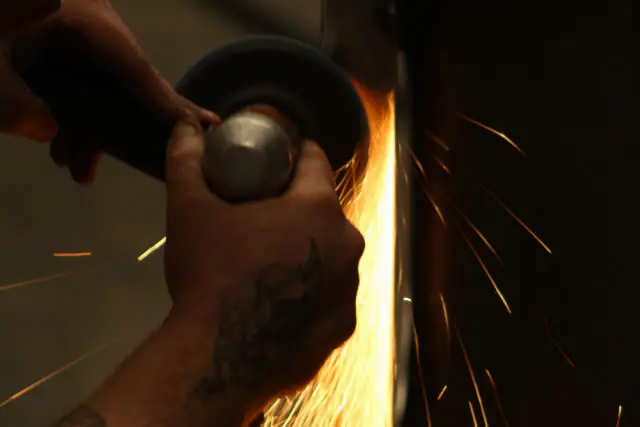
What is a Sheet Metal Design Guide?
Sheet metal design involves creating parts from flat sheet materials that are cut, bent, and formed into shape. This design guide provides some guidelines for engineers working in sheet metal to design parts to assist in manufacturability. It includes some tips for sizing and placing holes, limitations on dimensions and bends, and determining surface finish requirements.
At ETM Manufacturing, we work with customers to assist in ensuring that your design can be brought to life as you envision and at the most economic price and timeline.
Material Selection
Good sheet metal design begins with material selection. The chart below provides some of the key properties and applications for some of the most common types of material that our customers use. Our team of engineers can work with you to narrow in on the most appropriate material for your application.
| MATERIAL | KEY PROPERTIES | APPLICATIONS |
| Aluminum (5052, 6061) | Lightweight, corrosion-resistant, good formability | Enclosures, aerospace |
| Stainless Steel (304, 316) Cold Rolled Steel (CRS) | Corrosion-resistent, strong Inexpensive, strong, less corrosion resistance | Food-grade, medical Structural parts, general industrial |
| Copper & Brass | Good conductivity, formability | Electrical parts |
General Design Guidelines
- Use Standard Thicknesses:
- Thinner: .030”, .060”, .125” for thicknesses up to 125”
- Thicker: .125”, .250”, .375”, and .500”
- Minimum Bend Radius:
- Rule: bend radius >=material thickness
- For brittle materials: bend radius >= 2x thickness (such as 6061-T6 aluminum)
- Sharp bends can lead to cracking
- Minimum bend length >= 3x material thickness + inside bend radius
- Bend Relief
- Add bend reliefs to prevent tearing or deformation
- Relief depth >= 1.5x material thickness
- Relief width >= material thickness
- Hole Placement:
- Distance from hole center to bend edge >= 2x material thickness + bend radius
- Minimum distance between holes >= 2x material thickness
- Minimum Hole Size:
- Hole diameter >= material thickness
- Tabs & Slots:
- Tab width >= material thickness
- Slot width >= tool thickness or cutting kerf
Cutting & Manufacturing
| METHOD | PROS | CONS |
| Laser Cutting | Precise, complex shapes | Higher cost |
| Punching | Fast, scalable | Limited shape complexity |
| Waterjet | No heat-affected zone | Slower, expensive |
| Shearing | Cheap for straight cuts | Limited to basic shapes |
- Cutting Methods: (see table above)
- Tolerance Guidelines:
- Standard tolerance for bends: +/- 0.5mm
- Hole position tolerance: +/- 0.2 mm (varies by method)
Bending Considerations
- K-Factor and Bend Allowance:
- Account for material stretching during bends
- K-Factor (typically 0.3 – 0.5) defines where the neutral axis lies
- Use bend allowance formulas or CAD tools (best to consult manufacturer for their common bend deductions)
- Bend deductions are common and available on bend deduction charts
- Avoid Complex Bends:
- Prefer single or compound bends over tight or twisted geometries to increase manufacturability and reduce cost
- Avoid bending over holes or cutouts
- Grain Direction:
- Bend perpendicular to grain direction to reduce cracking
Design for Assembly
- Fasteners:
- Use PEM inserts, self-clinching nuts, or weld nuts
- Design access for tool clearance
- Consult PEM catalogues for hardware specs, hole to edge of part minimums, and material usages
- Tabs, Notches, and Lances:
- Use for self-locating parts during assembly
- Avoid tight fits that increase stress
Surface Finishing
| FINISH TYPE | PURPOSE |
| Powder Coating | Aesthetic, corrosion resistance |
| Anodizing | Used for aluminum; protective + decorative |
| Plating | Conductivity or protection |
| Brushing or Polishing | Surface texture |
Cost Reduction Tips
One of the most important ways that our engineers can assist your team is by identifying opportunities to meet design requirements while reducing cost to manufacture. Some tips to help:
- Standardize bend radii and materials
- Avoid unnecessarily tight tolerances
- Minimize tooling changes (same punch/die)
- Use standard hole sizes and shapes if possible
- Design for nesting (efficient material usage)
Design Checklist
Before you submit a design for a manufacturing quote, it’s helpful to check your design against this quick checklist:
- Are bend radii >= thickness?
- Are holes placed away from bends?
- Have you added reliefs near bends?
- Are fasteners accessible for installation?
- Have you considered finishing and grain direction?
- Are part geometries manufacturable with chosen tools?
At ETM Manufacturing, we specialize in bringing your ideas and products to life. We will partner with you to ensure that your design meets your desired needs and can be manufacturing in a timeline and at a price that meets your business needs.
What can we build for you?